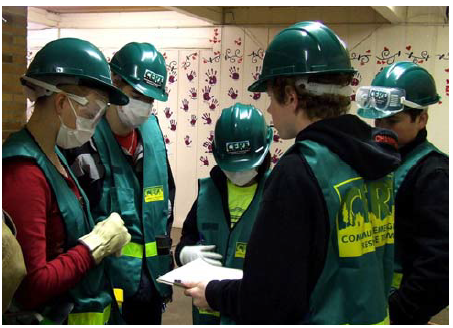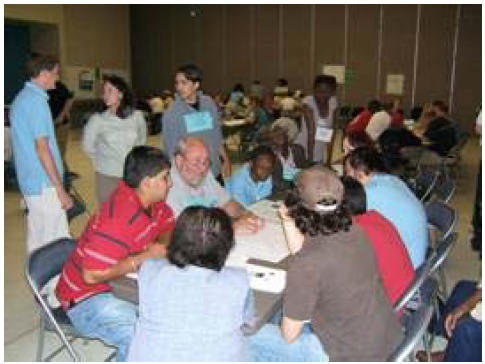Introduction
Since 1980, the United States has sustained 78 weather related disasters with overall damages and costs exceeding one billion dollars for each event. Sixty-six (85 percent) of these disasters occurred during or after 1990. The total cost for these 78 events was 600 billion dollars, using a GNP inflation index (National Oceanic and Atmospheric Administration). According to the American Red Cross (2008), their volunteers respond to more than 70,000 disasters each year. A search of the Federal Emergency Management Agency website reported 2027 disaster events from 1980 through 2007 (FEMA).
“Disasters, by definition, create an abundance of needs and a scarcity of resources. Tragically, disasters also amplify vulnerabilities and expose gaps in planning and service delivery” (Campbell, 2008, p. 5). Therefore, being prepared and understanding what can be done to mitigate damages sustained is critical.
While our uniformed first responders are the key component to disaster response and recovery, they number less than 1 percent of the total population. (National Preparedness Guidelines, 2007, p. 27). Therefore, it is imperative that all citizens understand their role in an emergency: how to be personally prepared and what their community’s emergency response personnel do in order to be ready for a disaster.
One method for preparedness planning is the Tabletop Exercise (TTX). The TTX is a scenario-based exercise in which participants “practice” their response techniques and strategies in planning for a real disaster. Tabletop exercises are primarily used by uniformed first responders, senior staff, community officials and decision-makers to identify strengths and weaknesses in the disaster planning process. Historically, participation was limited to community adults. However, disasters affect everyone, regardless of age. In addition, youth are not always in the company of an adult when a disaster strikes. Allowing youth to learn about the process involved in planning for disasters, and providing age-appropriate training in emergency preparedness, ensures that youth have a better understanding of personal and family safety in emergencies. Incorporating a youth perspective in the planning process may serve to expand the resources needed and provide missing insight into elements.
Tabletop Exercise
In a Tabletop Exercise, participants are given an emergency scenario applicable to their specific location. Following the Incident Command System (ICS) structure, participants decide what needs to be done and how they will respond while in a safe non-emergency environment. Since disaster response evolves as new information is obtained and additional needs are identified, updates are given to exercise participants requiring that they continually modify their response strategies. These updates are introduced through a series of new “inputs”.
An important step in a TTX includes time for the group to reflect and evaluate how well they responded to the mock scenarios. This evaluation process allows participants to identify strengths and weaknesses in their overall response plan and enables them to improve their strategic response to a real disaster. While tabletop exercises are primarily used to identify response gaps, an equally important part is practicing the scenario within the guidelines of the ICS.
Youth Involvement in Disaster Training
In 1992, FEMA endorsed the Community Emergency Response Team (CERT) concept, making it part of the Citizen Corp program. Citizen Corp was created to help citizens through public education and outreach, training and volunteer service during an emergency. CERT is a training program that prepares people to help themselves, their families, and their neighbors, in event of a disaster in their community. CERT members learn disaster response skills and can provide critical support to others before first responders arrive. Following the CERT concept, a Teen CERT program was developed. Teen CERT programs help students learn basic first aid, fire safety, search and rescue and emergency preparedness to help them personally, at home, their school and their community.

Oregon 4-H Teen CERT members discuss rescue strategy during a training activity
Teen CERT programs are growing around the United States with support from the Department of Homeland Security. Following the CERT training programs for adults, youth also learn needed strategies to assist their community. Teen CERT members are encouraged to support emergency response agencies by taking a more active role in emergency preparedness projects in their community. Just as young children can be taught how to identify an emergency and respond, i.e. “Stop, Drop, Roll,” “Call 9-1-1,” etc., older youth can also learn age appropriate emergency preparedness strategies.
Can Youth Do It?
Social norms have often followed the idea that youth should be recipients of the knowledge adults provide them, without allowing for much youth input. However, as research is now suggesting, youth should be provided with the chance to improve their leadership opportunities through experiential learning and become a part of the decision-making process in all areas, but especially in those directly affecting them (Innovation Center for Community and Youth Development). Youth-adult partnerships help youth plan for their future, under the guidance of caring adults. Youth learn about decision-making, responsible citizenship, personal safety, teamwork, communication and numerous other life skills. While the process involved in any youth-adult partnership requires conscientious input from adult collaborators, the reward of youth participation far outweighs the time required to educate the youth. Examples of youth civic involvement abound on the Internet; emergency response issues are no different. What is important is the recognition of age-appropriate activities. While pre-school, elementary and middle school youth can benefit from learning what to do in an emergency, training in CERT programs should be reserved for high school age-appropriate activities, because of cognitive development issues. According to the U.S. Census Bureau 7.2 percent of the U.S. population are youth ages 15 – 19. In addition, most research comparing late adolescents and adults have found “few differences between them in the decisionmaking processes they use,” (Arnett, 2004).
Youth at the Tabletop Exercise
In 2007, National Geographic Society supported a series of training opportunities in connection with hurricane disaster preparedness in the southeastern United States. Five trainings incorporated education in youth-adult partnerships, community development, geospatial technology, and community service. One component of the training was the inclusion of a modified tabletop exercise. Youth and adults were asked to assume various roles indicative of the mock scenario – a tornado hitting a high school. Following a brief Incident Command System overview, youth and adults strategized on how to respond to various tornado disaster issues presented. Youth were asked to assume leadership roles during the TTX.

Attendees at the Alert, Evacuate, and Shelter training in Petersburg, Virginia participate in a Tabletop exercise focusing on a high school hit by a tornado.
At the conclusion of the three-day training, participants, both youth and adults were asked to evaluate various components of the training, including the ICS component introduced during the tabletop exercise. While results of the evaluation were significant for all 19 questions surveyed, two of the evaluation questions specifically addressed the issues discussed here. Table 1 indicates statistically significant increases in knowledge, based on pre-test and post-test scores for: 1) ICS as a universal language and process for responding to a disaster and 2) the value of youth-adult partnerships.
Table 1: Alert, Evacuate, and Shelter Training Impacts
| Short Term Impacts |
Pre-Test |
Post-Test |
N |
| ICS as a universal language and process for responding to a disaster |
2.37 |
4.10ª |
127 |
| The value of youth-adult partnerships |
3.55 |
4.71ª |
138 |
Rating code: 5 = strongly agree; 1 = strongly disagree
aDifferences between pre-test and post-test mean scores statistically significant at p<.001
As with tabletop exercises traditionally attended by adults only, these trainings witnessed the progression from a beginning chaos, like a disaster situation, to one in which youth were working collaboratively with adults to ensure the safety and wellbeing of others. Youth showed they were capable of analyzing the situation and providing appropriate concrete strategies to address the issues. Since uniformed first responders comprise less than 1 percent of the total population, it is important to realize that all citizens need this knowledge, and that youth can also assist in the planning process.
Conclusion
While youth have historically been recipients of basic personal safety education in emergency preparedness, they have not been included in community wide preparedness activities. However, that may be changing. Youth afforded the opportunity to participate in the decisionmaking process, especially in topics that affect them, are becoming more engaged with their adult partners, learning important lessons and life skills. Since disasters affect everyone, including youth, it is important that youth be involved in the planning process. Through education, training and practice, youth can assist their families and community members in responding to emergencies.
References
American Red Cross – Disaster Services (2008) ARC.
Arnett, J (2004). Adolescence and Emerging Adulthood, A Cultural Approach by Jeffrey Jensen Arnett, University of Maryland; Pearson Education Inc. Upper Saddle River, NJ.
Billion Dollar Weather Disasters 1980 – 2007. NOAA’s National Climatic Data Center. Retrieved July 28, 2008 from NOAA.
Campbell, J. guest editor. Introduction – Applying the ‘Disaster Lens’ to Older Adults. Generations: Journal of the American Society on Aging, 16, 4. Winter 2007- 2008. San Francisco, CA.
CitizenCorp
Engaged Citizens. Chevy Chase, MD. The Innovation Center for Community and Youth Development and The Ford Foundation.
FEMA: FEMA News. Retrieved July 8, 2008 from FEMA.
FEMA Course IS 120A – An Introduction to Exercises. Retrieved July 28, 2008.
Jones, K., Byer, K., & Zeldin, S. (2008). Youth-Adult Partnerships: In Community Decision Making: An Evaluation of Five State 4-H Youth in Governance Programs. Chevy Chase, MD, National 4-H Council. 4/08 500-YAP002.
Mohamed, I. and Wheeler, W. (2001) Broadening the Bounds of Youth Development: Youth as Teen CERT at Michigan State University. Center for Regional and National Security, Eastern Michigan University. Retrieved July 28, 2008 from Teen CERT
National Preparedness Guidelines (September 2007), U.S. Department of Homeland Security, page 27.
Powell, P., Black, L., Benesh, C., and Smith, M.
2008,
Emergency Preparedness and The Tabletop Exercise: How Youth Can Play a Part in the Process,
Extension | University of Nevada, Reno, FS-08-36


